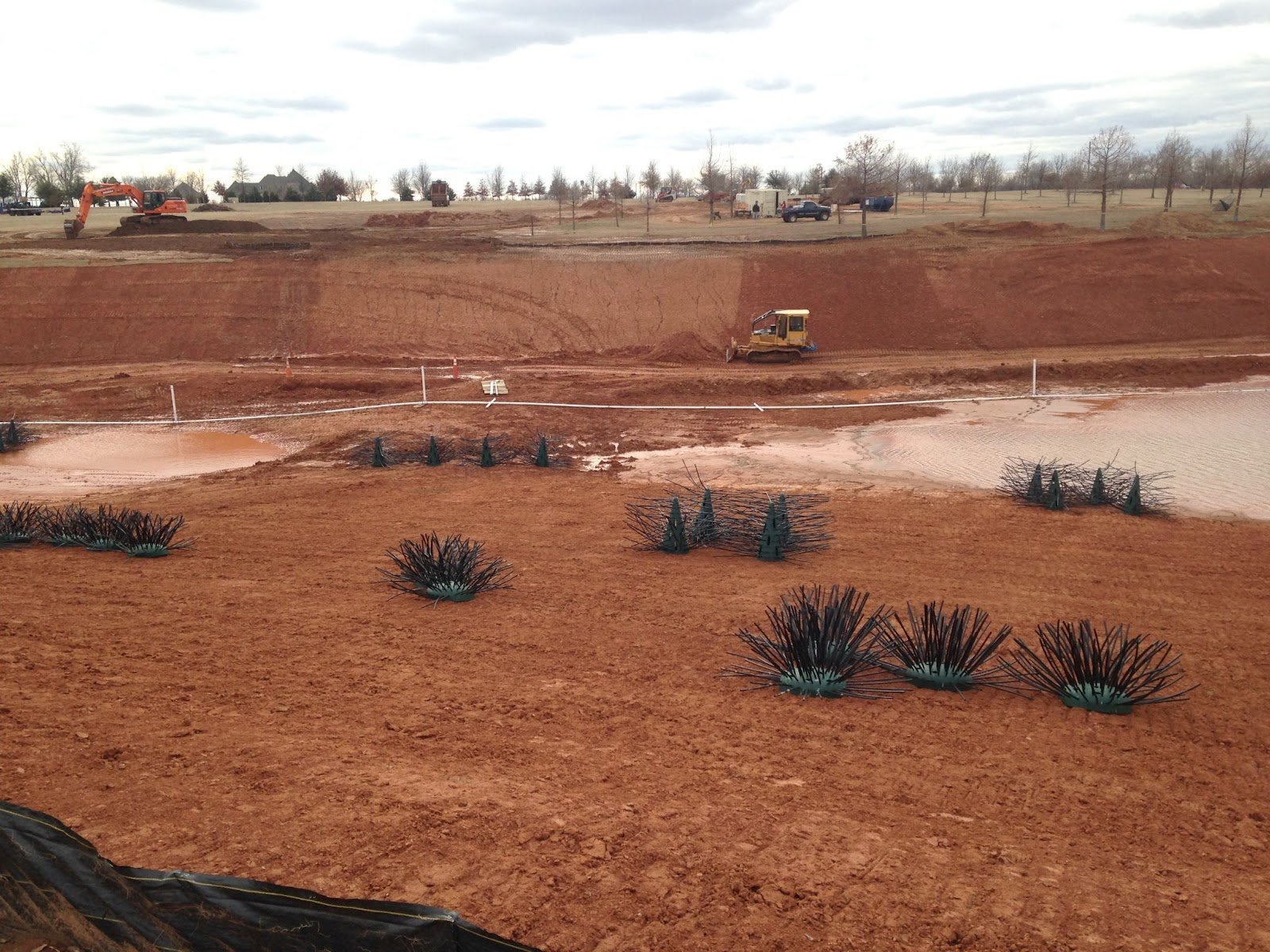Maintaining proper density and abundance of available fish habitat is a very important part of your pond and lake management plan.
To help gain a better understanding of how much habitat is needed within a pond or lake, we put together a few examples based around a one-acre pond. You can scale these recommended numbers of fish habitat structures to fit your pond and lake management plan by multiplying or dividing according to your pond size and/or your budget.
How Much Habitat is Recommended for Fish?
As a general rule of thumb 10 – 20% of the total surface area of the lake should be providing some form of available fish habitat.
Examples of available fish habitat include:
- timber
- laydowns
- brush piles
- rock piles
- contour changes
- aquatic vegetation
- artificial habitat that is present within the lake
In the first two examples we share how much artificial fish habitat would be necessary to achieve 10 and 15% of the total surface area in a new one-acre lake.
Then, in the final two, we show how to take into consideration existing habitat (things like aquatic vegetation and a floating dock) when determining how many artificial fish habitat structures are necessary in an existing pond.
Calculate How Much Coverage of Fish Habitat You Need for your Pond
First things first, you need to know how much area your habitat will need to cover, so let’s do some math. Since one surface acre is 43,560 square feet (sq. ft.), maintaining habitat with 10-20% coverage requires 4,356 sq. ft. to 8,712 sq. ft. of area providing available fish habitat.
Consider How Fish Relate to Cover to Help You Determine Habitat Needs
Determining the area your habitat provides can often be deceptive as it is important to also consider the area around the piece of habitat. Fish that are relating or associating with habitat/cover will not always be in the heart of it.
Oftentimes fish position themselves outside of habitat in order to ambush prey using the habitat for refuge, or when they are inactive, the habitat provides a quick safe refuge if it is needed.
As a result, the area of available habitat each piece of structure provides is greater than expected. Grouping multiple pieces of fish habitat together can further amplify this effect and offer greater available area around and between the artificial fish habitat structures.
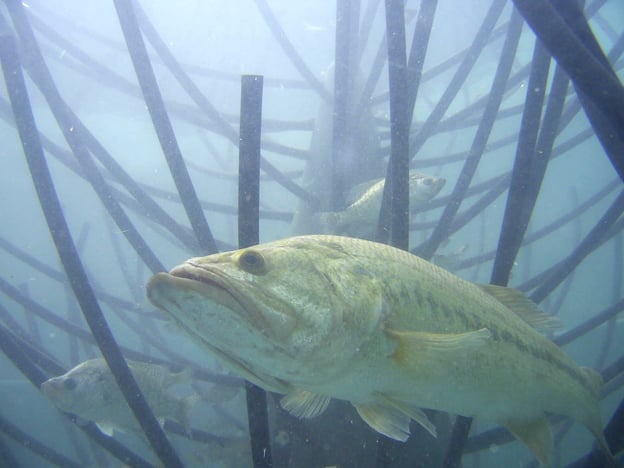
When placing artificial fish habitat structures, we recommend placing them in groups of two or more in order to take advantage of the increased area and complexity.
What are the Best Groupings for Artificial Fish Habitat?
As a general rule, when placing habitat in groups of 2 to 5, the available area provided by the structures is roughly 2 times the number of individual habitats.
Groups of artificial fish habitat structures greater than 5 can have their areas estimated at 2.5-3 times the number of individual habitats.
Example #1:
- 1- Honey Hole Tree has an area of 49 sq. ft.
- A group of 3 Honey Hole Trees provides an area of available habitat approximately equal to 7 Trees (a little more than 2 times the number of Trees).
- The total area provided is then calculated as 7 Honey Hole Trees x 49 sq. ft. (per Tree) = 343 sq. ft. of available habitat.
Example #2:
- Let’s say you have cedar trees that you will be sinking in your pond to use as natural fish habitat and they are 6 ft. in diameter.
- The area of a single cedar tree would be approximately 28.3 sq. ft. per tree.
- If you sink a group of 7 together, the provided area would be approximately equal to 20 trees (2.5 to 3 times the number of trees for groups over 5) when accounting for the area around and between trees.
- The total area of available habitat would then be calculated as 20 trees x 28.3 sq. ft. = 566 sq. ft. of habitat.
To help simplify things, here are a few images showing plans based on a one-acre pond utilizing our Honey Hole Trees. This will give you an idea on how many artificial fish habitat structures are needed to provide the proper habitat availability for your fish pond management plan.
Artificial Fish Habitat Structures in a New Pond
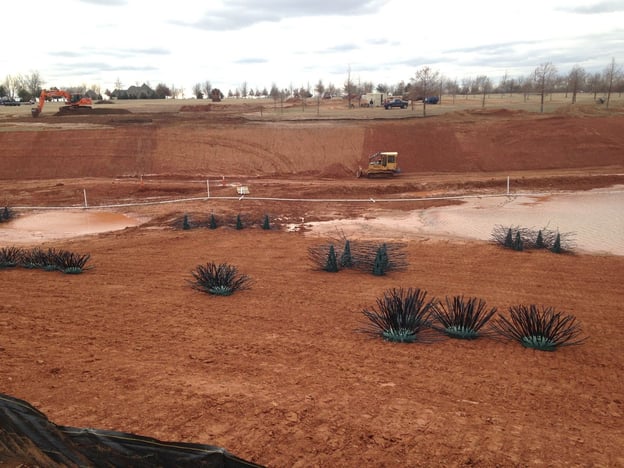
Within both of these examples, area was calculated under the assumption that the only habitat present within the lake was the artificial fish habitat - the Honey Hole Trees. There were no natural structures or structural elements that would provide additional habitat.
These examples were aimed to mimic a newly dug pond with minimal contour changes.
New Pond Habitat Coverage Recommendation
Here we have a 1 acre pond, with 10% of the newly placed, artificial habitat throughout. This placement has 38 Honey Hole Trees to account for the submerged habitat.
New Pond: 10% Artificial Fish Habitat Coverage
38 Honey Hole Trees

And for you math gurus, here’s how we got to these numbers:
- 1 acre = 43,560 sq ft X 10% = 4,356 sq. ft. of coverage needed
- 1 cluster of 3 Trees gives 343 sq. ft. of available habitat (from the earlier example)
- 4,356 sq. ft. / 343 sq. ft. = 12.7 clusters X 3 Trees per cluster = 38 Honey Hole Trees
Next, we have added more honey hole trees to help boost overall habitat coverage to reach 15% of total lake area.
New Pond: 15% Artificial Fish Habitat Coverage
53 Honey Hole Trees
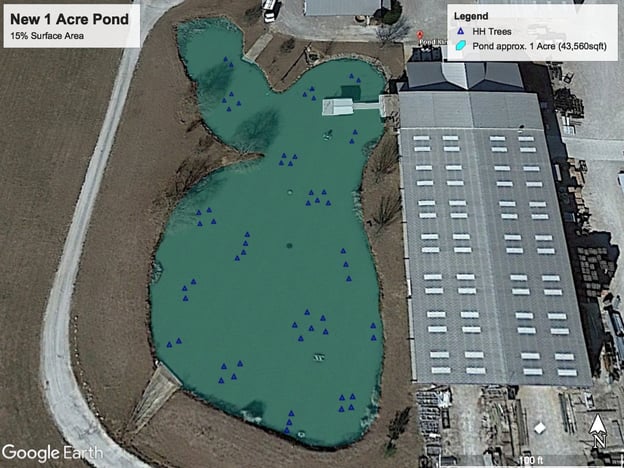
Here is the actual breakdown of numbers based on the recommended placement and clustering we show in the image above:
1 acre = 43,560 sq ft X 15% ~ 6,534 sq. ft. of coverage needed
Using the earlier examples for available habitat counting space between:
- 2 clusters of 2 Trees is equivalent to 5 Trees x 49 sq. ft. = 245 sq. ft. of available habitat per cluster. 5 clusters of 2: 5 x 245 = 1,225 sq. ft.
- 1 cluster of 3 Trees gives 343 sq. ft. of available habitat. 4 clusters of 3: 4 x 343 = 1,372 sq. ft.
- 1 cluster of 4 Trees is equivalent to 9 Trees x 49 sq. ft. = 441 sq. ft. of available habitat. 6 clusters of 4 = 2,646 sq. ft.
- 1 cluster of 5 Trees is equivalent to 13 Trees x 49 sq. ft. = 637 sq. ft. of available habitat.
- 1 cluster of 6 Trees is equivalent to 15 Trees x 49 sq. ft. = 735 sq. ft. of available habitat.
- TOTAL ARTIFICIAL COVERAGE: 1,225 + 1,372 + 2646 + 637 + 735 = 6,615 sq. ft.
- (6,615 / 43,560) * 100 = 15.1% surface area coverage
If you’ve just dug a new pond, hopefully these examples give you an idea of how much artificial fish habitat will be needed to be within the recommended range for trophy pond management on a one-acre pond.
Artificial Fish Habitat Structures in an Existing Pond
If you have an existing pond, when calculating the amount of fish habitat coverage you need, make sure to take into account any existing habitat such as: aquatic vegetation, docks, contour changes, etc.
The following example will take these into account and adjust habitat quantities accordingly to maintain 10% coverage of available fish habitat.
Existing Pond with Goal of 10% Fish Habitat Coverage
Supplemental Artificial Fish Habitat: 27 Honey Hole Trees
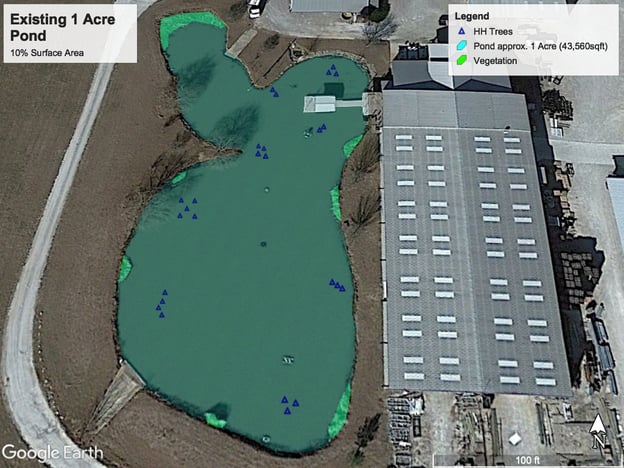
Within this example, measurements of existing aquatic vegetation and the floating dock were made through use of Google Earth Pro to estimate approximate coverage.
The combined area from the dock and aquatic vegetation was roughly 1,400 sq. ft. and reduced the minimum habitat coverage from 4,356 sq. ft. to just under 3,000 sq. ft. needing to be composed of artificial fish habitat.
Here’s a breakdown of how it’s calculated:
- 1 acre = 43,560 sq ft X 10% = 4,356 sq. ft. of coverage needed
- Existing habitat: (Dock) 472 sq. ft + (Vegetation) 946 sq. ft = 1,418 sq. ft.
- 4,356 - 1,418 = 2,938 sq. ft. additional coverage needed
- 1 cluster of 3 Trees gives 343 sq. ft. of available habitat (from the earlier example)
- 2,938 sq. ft. / 343 sq. ft. = 9 clusters X 3 Trees per cluster = 27 Honey Hole Trees
What is the Optimal Habitat Coverage for Ponds and Small Private Lakes?
After decades of installing habitat in ponds around Texas and Oklahoma, we have found that the ideal coverage or fish habitat for a lake is 18%. When you achieve 18% coverage, you are providing ample habitat for your forage fish to feel safe and great opportunities for your bass to feed.
The Professional Fish Habitat Recommendation for a 1 Acre Pond
In this final example we took into account the already existing habitat (aquatic vegetation and floating dock) but increased the total habitat availability within the pond to 18% of the total area. This is to represent an ideal habitat availability and composition utilizing both the Honey Hole Tree and Honey Hole Shrub.
Existing Pond: 18% Ideal Fish Habitat Coverage
Supplemental Artificial Fish Habitat: 43 Honey Hole Trees, 18 Honey Hole Shrubs
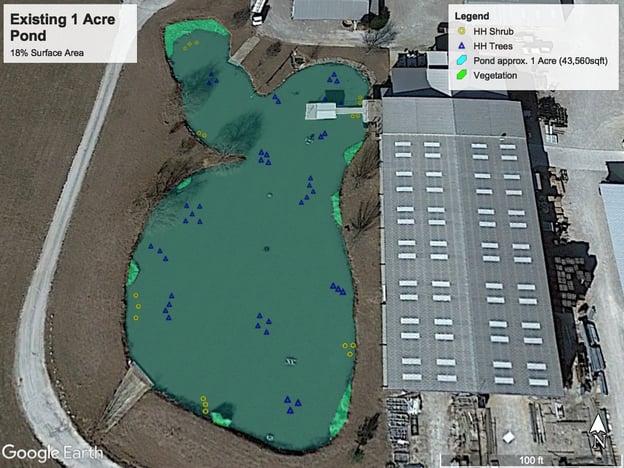
Put your math hats on! Here’s how we got to these numbers:
- 1 acre = 43,560 sq ft
- Existing habitat: 472 sq. ft + 946 sq. ft = 1,418 sq. ft.
- ARTIFICIAL HABITAT
- 1 tree is equivalent to 3 Trees x 49 sq. ft. = 147 sq. ft.
- 2 trees by the dock: 147 X 2 = 294 sq. ft.
- 1 cluster of 2 Trees is equivalent to 5 Trees x 49 sq. ft. = 245 sq. ft. of available habitat per cluster.
- 2 clusters of 2: 2 x 245 = 490 sq. ft.
- 1 cluster of 3 Trees gives 343 sq. ft. of available habitat.
- 5 clusters of 3: 5 x 343 = 1,715 sq. ft.
- 1 cluster of 4 Trees is equivalent to 9 Trees x 49 sq. ft. = 441 sq. ft. of available habitat.
- 3 clusters of 4 = 1,323 sq. ft.
- 1 cluster of 5 Trees is equivalent to 13 Trees x 49 sq. ft. = 637 sq. ft. of available habitat.
- 2 clusters of 5 = 1,274 sq. ft.
- TOTAL HABITAT COVERAGE OF TREES: 5,096 sq. ft.
- 1 Shrub has a footprint of 6 ft. X 6 ft. = 36 sq. ft.
- 1 cluster of 2 Shrubs is equivalent to 5 Shrubs X 36 sq. ft. = 180 available sq. ft.
- 3 clusters of 2: 3 X 180 = 540 sq. ft.
- 1 cluster of 3 Shrubs is equivalent to 7 Shrubs X 36 sq. ft. = 252 available sq. ft.
- 4 clusters of 3: 1,008 sq. ft.
- TOTAL HABITAT COVERAGE OF SHRUBS: 1,548 sq. ft.
- TOTAL ARTIFICIAL COVERAGE: 1,548 + 5,096 = 6,644 sq. ft.
- Total Habitat Coverage: 1,418 + 5,096 + 1,548 = 8,062 sq. ft.
- (8,025 / 43,560) * 100 = 18.5% surface area coverage
How Should a Private Pond Owner Plan Their Fish Habitat?
Habitat diversity is important to consider when putting together a habitat plan.
Establishing a mixture of more complex refuge style habitats such as aquatic vegetation or Honey Hole Shrubs with more open ambush structures such as Honey Holes Trees provides suitable habitat for all species and age classes.
Floating docks provide mostly shade and mixing additional habitat near a dock is recommended, especially when around deeper water.
For more detailed information on habitat placement you can check out our other fish habitat blogs, including “Habitat Placement for Bluegill Production” and “Designing the Perfect Bass Habitat”.
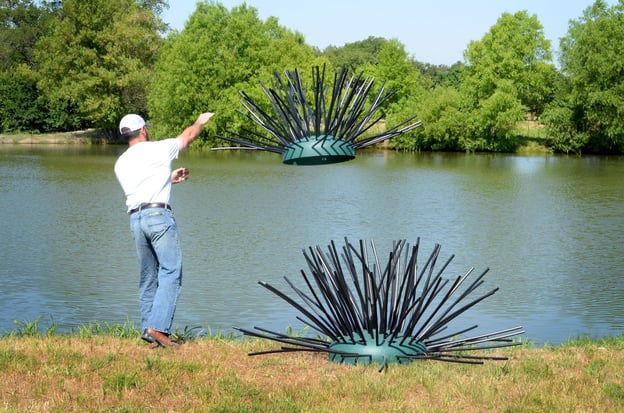
Hopefully this article has given you a better understanding of how we design fish habitat plans for trophy pond management and you can take this information and apply it to your own lake management plan.
Mix and Match Your Artificial Habitat Over Time!
The beauty of artificial fish habitat is that you don’t have to purchase it all at once. These numbers are to give you a starting point for how much habitat is needed to provide the recommended coverage. You can purchase some over time and add to the pond as your budget allows.
Try Pond King Fish Habitat for Your Private Lake
Creating a fish pond management plan for the first time can be overwhelming and confusing, but it doesn’t have to be. At Pond King, we are here to help! Call or contact a member of the Pond King team with any questions or needs determining how much habitat is necessary for your lake or pond.
We’ll see y’all down at the pond!


